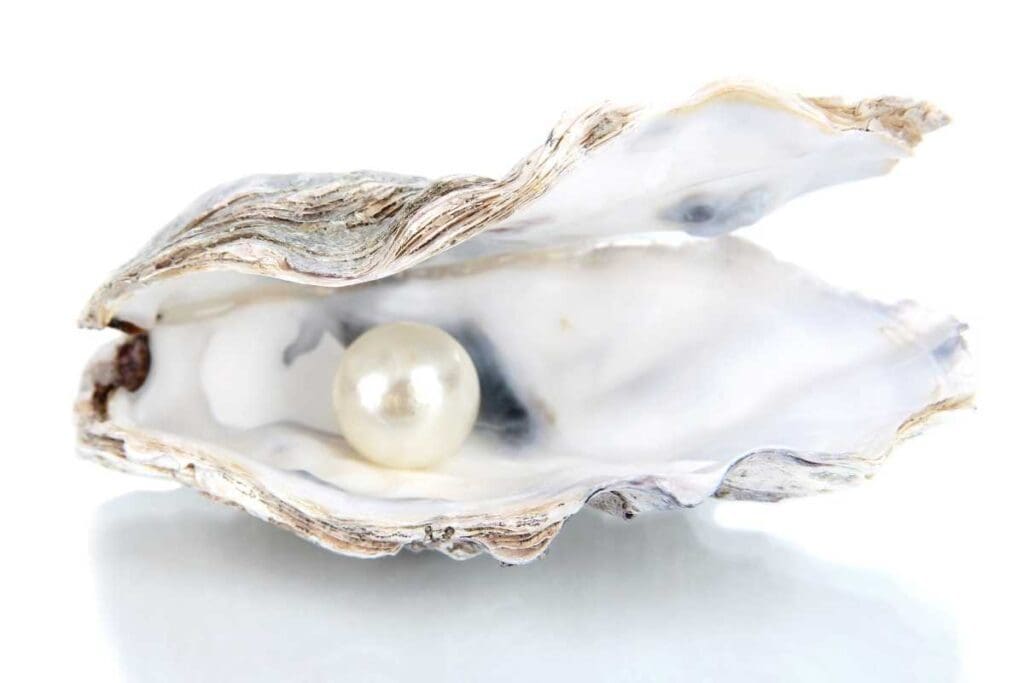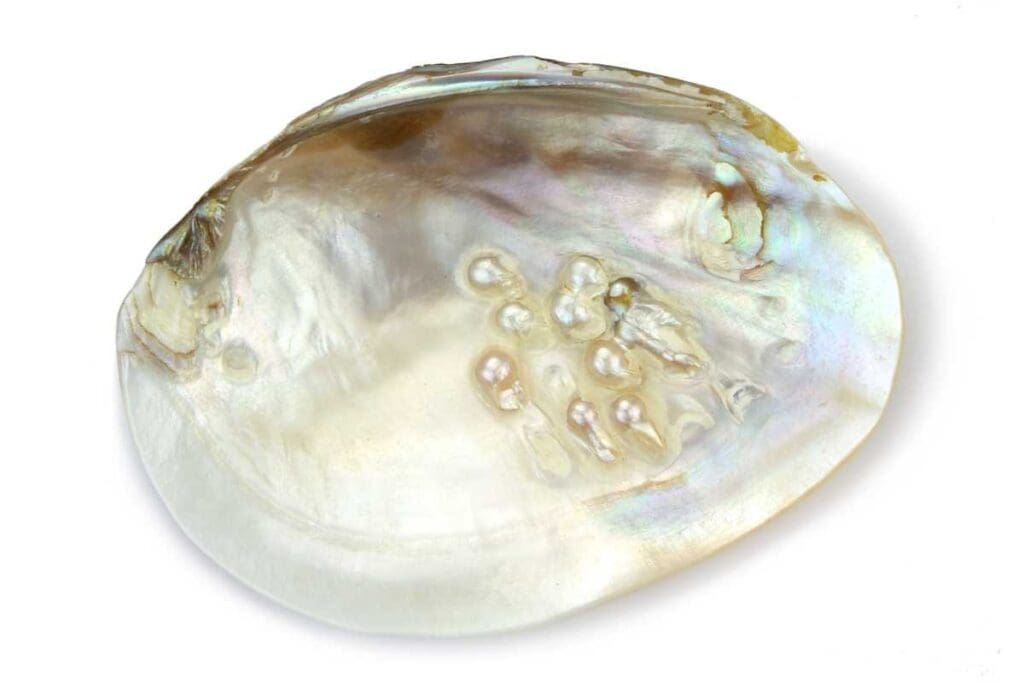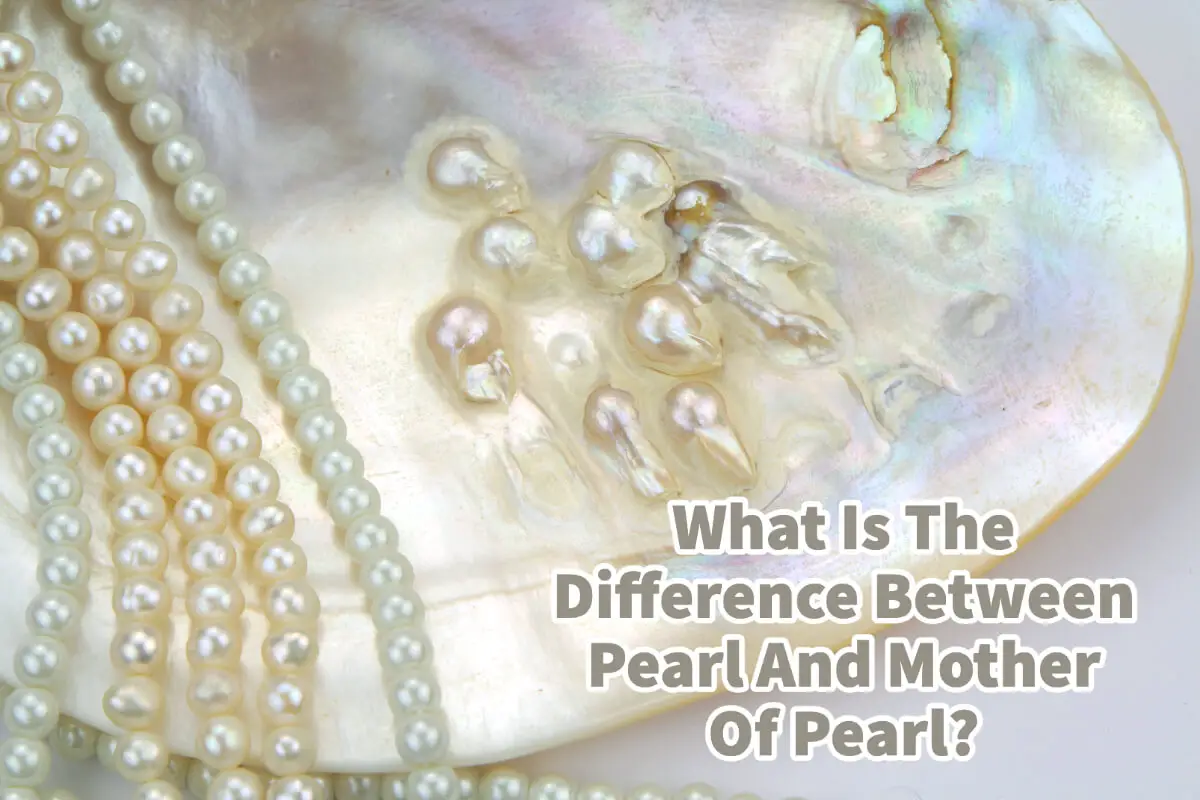It can be unclear sometimes when you hear the name pearl and mother of pearl and what the difference is. Even though they use the name pearl, they are not precisely the same.
A pearl is formed when an irritant is placed in a mussel or oyster so that a round pearl is formed around the irritant. The material used to create a pearl is the mother of pearl or nacre; this material goes over the irritant in the shell to form the pearl. The mother-of-pearl is essentially the same kind of shell without the irritant or pearl being developed; the shell is then cut and polished into shapes for mother-of-pearl home decor and furniture items or other products.
Table of Contents
- Pearl And Mother Of Pearl Defined
- How Pearls Are Formed
- How Mother Of Pearl Is Formed
- Pearl And Mother Of Pearl Differences
- Related Content
Pearl And Mother Of Pearl Defined
Pearl and the Mother of pearl are very similar, but they have some differences. When we look at the definition of each of them, we can see some of their unique properties.
The Oxford Dictionary defines a pearl as:
“A hard, lustrous spherical mass, typically white or bluish-gray, formed within the shell of a pearl oyster or other bivalve mollusk and highly prized as a gem.”
Oxford Dictionary
In the same Oxford dictionary, the term mother of pearl is also defined as:
“a smooth shining iridescent substance forming the inner layer of the shell of some mollusks, especially oysters and abalones, used in ornamentation.”
Oxford Dictionary
The definition of a pearl and a mother of pearl clarifies the differences between a pearl and a mother of pearl. Even if they are produced from the same or similar material, they have some unique differences.
One of the significant differences in the value of the pearl vs. the mother of pearl. A pearl can be precious, especially one perfectly round and naturally formed in the pearl oyster.
Some pearls can go for millions of dollars. In 2018, Marie Antoinette’s pearl pendant sold for 32 million dollars.
How Pearls Are Formed

One of the significant differences between a mother of a pearl and a pearl is how the pearls are formed. Today, finding a natural pearl, especially a perfectly round one, is very hard to find. Because the naturally formed pearls can be so rare, they are usually expensive,
How Natural Pearls Are Formed
Natural pearls are formed when some irritant, usually a tiny organism, makes its way into the shell of a mollusk as an oyster or mussel. To protect itself from the invader, the mollusk will start to coat the invading organism with what is known as nacre or mother of pearl; this is the same material that lines the inner layer of a mother of pearl shell.
The mollusk or oyster coats the invading organism until a shiny pearl is formed. Finding a natural round pearl can be challenging as this is a natural process.
How Cultured Pearls Are Formed
Cultured pearls are formed in the same process as natural ones, but the irritant enters the shells intentionally by a human being and not by nature. Pearl farmers insert an irritant into the mollusk tissue where they want the pearl to grow.
The oyster or mussel will start the same process as the natural pearl, using the nacre or mother of pearl to cover the irritant.
As a natural pearl is so rare and hard to find, most of the pearls on the market are cultured. To know if a pearl is cultured or natural, it is X-rayed to see it inside and tell how it was formed.
Cultured pearls date back to 500 AD in China. In 1893, Kokichi Mikimoto streamlined the pearl production process and produced perfectly round pearls; today, Mikimoto pearls are considered some of the best on the market.
The color of the pearl can depend on the type of mollusk used. For example, the famous black Tahitian pearls are black because they used mostly black Pinctada margaritifera oysters; the pearl’s colors can vary according to the culturing process and mollusk or oyster used.
How Mother Of Pearl Is Formed

Mother of pearl is essentially the same kind of mollusk as the pearl, but there is no irritant placed in the pearl to force the oyster or mussel to protect themselves from forming a pearl. Like a pearl, the color of the mother of pearl will depend upon what kind of mollusk is used.
Mollusks of different colors will produce various inner shells or colors. Some could be perfectly white, others pink, and some grey, black, or iridescent. It will all depend on the type of mollusk and the inner color of that mollusk.
Mother of pearl can be found in the ocean or grown on what is known as a pearl farm. Today, many are harvested on pearl farms.
No part of the oyster or mussel is wasted when it is harvested for mother of pearl. The meat or mussel will be eaten, and the shell will be used to produce the mother-of-pearl products.
Pearl And Mother Of Pearl Differences
The main difference between a pearl and a mother of pearl is not the material or the mollusk but how each is formed. A pearl is usually purposely created by placing an irritant into the shell so the pearl is formed around the irritant.
On the other hand, the mother of pearl is a shell without the irritant and is just the shell. They can be the same or similar in terms of nacre or material, but the end product and how they are used are entirely different.
A pearl is considered a valuable gem, so it is usually used for jewelry such as a pearl necklace. A pearl’s value is also determined by its size, roundness, and color.
Not all pearls are considered valuable; in fact, many are not. Getting a very round, high-quality pearl from a shell of an oyster or mussel is not easy and can be pretty tricky.
Mother of pearl is also from the mollusk, but there is no irritant or pearl formed in the shell. In that case, the shell of the oyster or mussel is cut and polished so that it can be used for the mother of pearl home decor, furniture, or other objects such as pearl buttons and jewelry.
If you are interested in seeing how Mondoro can help you manufacture mother of pearl home decor and home furnishing products – we would love to talk to you to see how we can help you.
Find out more about how Mondoro can help you create, develop, and manufacture excellent home decor and home furniture products – don’t hesitate to contact me, Anita. Check out my email by clicking here or become a part of our community and join our newsletter by clicking here.
Mondoro gives out a FREE Lookbook to anyone interested. You can receive a copy of our latest Lookbook by clicking here.
Listen to our Podcast called Global Trade Gal. You can find it on all major podcast platforms. Try out to listen to one of our podcasts by clicking here.
Subscribe to our Mondoro Company Limited YouTube Channel filled with great videos and information by clicking here.
Related Content
Lacquerware And Mother Of Pearl – 10 Reasons We Love Them!
There are many reasons why we love lacquerware and mother-of-pearl products. Lacquerware and mother of pearl are high-quality handmade products that can produce a variety of finishes and techniques in various shapes and sizes.
You can discover more by reading Lacquerware And Mother Of Pearl – 10 Reasons We Love Them! by clicking here.
How To Clean Mother Of Pearl Furniture And Home Decor Items
You can use several methods to clean your mother-of-pearl furniture and home decor items. One method is to use a soft cloth and mild soap to wipe down the mother of pearl; this will help remove any dust and clean the surface. The other method uses natural, olive, or coconut oil to polish the mother-of-pearl surface.
You can discover more by reading How To Clean Mother Of Pearl Furniture And Home Decor Items by clicking here.
How do you identify if the mother of Pearl is real? Spotting What’s Fake
When considering a Mother of Pearl for home decor and home furnishing products, you need to ensure that the mother of pearl you are getting is the highest quality real Mother of Pearl. You can do some basic tests to help you ensure that the Mother of Pearl you purchase is a natural material and not a fake version of Mother of pearl.
You can discover more by reading How To Identify If Mother Of Pearl Is Real? Spotting What’s Fake by clicking here.


